Source http://zenhabits.net/deliberate/
Our lives are often spent in a rush, almost on autopilot, drifting from one wave of busyness and distraction to another, adrift in a sea of crises and urges.
There’s noise and quick tasks, lots of tabs, messages and requests, demands on our attention, multitasking, mind scattered everywhere.
The nature of the world is chaos, but what if we could find a more deliberate way of moving through the chaos?
I’m going to share some ways I’ve been trying to move more deliberately — none of them new to me or you, but more of a coming back to what I know to be helpful. We’re always coming back.
- Set intentions at the start. When you start your day, or any meaningful activity, check in with yourself and ask what your intentions are for the day or that activity. Do you want to be more present? Do you want to move your mission forward? Do you want to be compassionate with your loved ones? Do you want to practice with discomfort and not run to comfort? Set an intention (or three) and try to hold that intention as you move through the day or that meaningful activity.
- Pick your important tasks & make them your focus. What tasks are meaningful to you today? Pick just three (or even just one) and focus on that first. Put aside everything else (you can come back to all that later) and create space for what’s meaningful in your life.
- One activity at a time. If you’re going to write, close all other tabs and just write. If you’re going to brush your teeth, just do that. If the activity is important enough to include in the limited container of your life, it’s important enough to give it your full focus. Treat it as if it might be your last act on earth.
- Use any activity as a meditation. This is really the same as the item above, but every single act is an opportunity to be fully with the activity. Everything we do can be a practice in breath, in presence, in deep consciousness. Treat each act as sacred, and practice.
- Create more space. Instead of filling every minute of the day with space, what would it be like to have some time of rest, solitude, quietude and reflection? My tendency (like many people, I suspect) is to finish one task and then immediately launch into the next. When there’s nothing to do, I’ll reach for my phone or computer and find something to read, to learn about, to respond to — something useful. But space is also useful. What would it look like to include space in our lives? Giving each activity an importance, and when it’s done, giving some weight to the space between activities. Taking a pause, and taking a breath. Reflecting on how the activity went, how I held my intention, how I want to spend the next hour of my life. Moving deliberately in that space, not rushing through it.
- Be in silence more. Our days are filled with noise — talking, messaging, taking in the cacophony of the online world. What if we deliberately created a space or two each day for being in silence? That could look like a couple of meditation sessions, a walk out in nature, a bath where we don’t read but just experience the bath, a time for tea and nothing else but the tea, or just stopping to watch a sunset (without taking photos). Silence is healing to the soul.
- Create containers for messaging & other chaos. We need to respond to emails and messages, read the news and catch up on things. But this chaos doesn’t have to fill our entire lives. Create a container for each of these activities: set aside 30 minutes for responding to all your emails, another 30 minutes for messages (maybe 2-3 times a day), and so on. In each container, do nothing but that activity. When you’re done, leave that activity until you need to come back to it deliberately.
- Simplify by limiting or banning. We don’t have to say yes to every French fry or cookie, or every Youtube video or beer. We can choose what we want in our lives deliberately, and what we don’t want (or want less of) … then set limits or ban that activity. For example, can you limit sugar to one treat every week? Or go a month without alcohol? Or only watch Youtube videos between 6-7 pm? These kinds of limits help us to simplify and be more deliberate.
- Listen to what life is calling you to do. As we sit in silence, as we move deliberately into spaces we’ve created, as we check in with our intentions … we can listen. Listen to life, God, the universe, whatever you want to listen to … and see what its calling you to do. Maybe it’s just your own heart. But you’re being called, and if you listen, you will hear it.
When you add these together — and you don’t have to be perfect at any of them — they flow into a beautiful way to move through life.
Source http://zenhabits.net/deliberate/
Our lives are often spent in a rush, almost on autopilot, drifting from one wave of busyness and distraction to another, adrift in a sea of crises and urges.
There’s noise and quick tasks, lots of tabs, messages and requests, demands on our attention, multitasking, mind scattered everywhere.
The nature of the world is chaos, but what if we could find a more deliberate way of moving through the chaos?
I’m going to share some ways I’ve been trying to move more deliberately — none of them new to me or you, but more of a coming back to what I know to be helpful. We’re always coming back.
- Set intentions at the start. When you start your day, or any meaningful activity, check in with yourself and ask what your intentions are for the day or that activity. Do you want to be more present? Do you want to move your mission forward? Do you want to be compassionate with your loved ones? Do you want to practice with discomfort and not run to comfort? Set an intention (or three) and try to hold that intention as you move through the day or that meaningful activity.
- Pick your important tasks & make them your focus. What tasks are meaningful to you today? Pick just three (or even just one) and focus on that first. Put aside everything else (you can come back to all that later) and create space for what’s meaningful in your life.
- One activity at a time. If you’re going to write, close all other tabs and just write. If you’re going to brush your teeth, just do that. If the activity is important enough to include in the limited container of your life, it’s important enough to give it your full focus. Treat it as if it might be your last act on earth.
- Use any activity as a meditation. This is really the same as the item above, but every single act is an opportunity to be fully with the activity. Everything we do can be a practice in breath, in presence, in deep consciousness. Treat each act as sacred, and practice.
- Create more space. Instead of filling every minute of the day with space, what would it be like to have some time of rest, solitude, quietude and reflection? My tendency (like many people, I suspect) is to finish one task and then immediately launch into the next. When there’s nothing to do, I’ll reach for my phone or computer and find something to read, to learn about, to respond to — something useful. But space is also useful. What would it look like to include space in our lives? Giving each activity an importance, and when it’s done, giving some weight to the space between activities. Taking a pause, and taking a breath. Reflecting on how the activity went, how I held my intention, how I want to spend the next hour of my life. Moving deliberately in that space, not rushing through it.
- Be in silence more. Our days are filled with noise — talking, messaging, taking in the cacophony of the online world. What if we deliberately created a space or two each day for being in silence? That could look like a couple of meditation sessions, a walk out in nature, a bath where we don’t read but just experience the bath, a time for tea and nothing else but the tea, or just stopping to watch a sunset (without taking photos). Silence is healing to the soul.
- Create containers for messaging & other chaos. We need to respond to emails and messages, read the news and catch up on things. But this chaos doesn’t have to fill our entire lives. Create a container for each of these activities: set aside 30 minutes for responding to all your emails, another 30 minutes for messages (maybe 2-3 times a day), and so on. In each container, do nothing but that activity. When you’re done, leave that activity until you need to come back to it deliberately.
- Simplify by limiting or banning. We don’t have to say yes to every French fry or cookie, or every Youtube video or beer. We can choose what we want in our lives deliberately, and what we don’t want (or want less of) … then set limits or ban that activity. For example, can you limit sugar to one treat every week? Or go a month without alcohol? Or only watch Youtube videos between 6-7 pm? These kinds of limits help us to simplify and be more deliberate.
- Listen to what life is calling you to do. As we sit in silence, as we move deliberately into spaces we’ve created, as we check in with our intentions … we can listen. Listen to life, God, the universe, whatever you want to listen to … and see what its calling you to do. Maybe it’s just your own heart. But you’re being called, and if you listen, you will hear it.
When you add these together — and you don’t have to be perfect at any of them — they flow into a beautiful way to move through life.
Source https://www.nerdfitness.com/blog/inverted-row-are-you-missing-out-on-this-great-exercise/
When I go to the gym, I try to keep things as simple and efficient as possible.
I’m a huge supporter of pull ups and chin ups, as those are the exercises that are a great test of somebody’s fitness level.
There’s just something inherently badass about being able to lift up your entire body, which is why competitions like Ninja Warrior require ridiculous back and bicep strength.
I know many people reading this article could be just getting started with fitness training, and doing a pull up seems like an absolute impossibility.
That’s okay! I’d guess that 80% of this country probably can’t do a pull up either, so don’t beat yourself up too much. Just because you can’t do a pull up now doesn’t mean you shouldn’t work out your back.
We HAVE written a resource on how to get your first pull-up here, but let’s start with the steps before that!
I have just the exercise for you instead: the bodyweight row! It’s a great exercise you can work on as you start to delve deeper into the wonderful world of strength training!
The Bodyweight (Inverted) Row
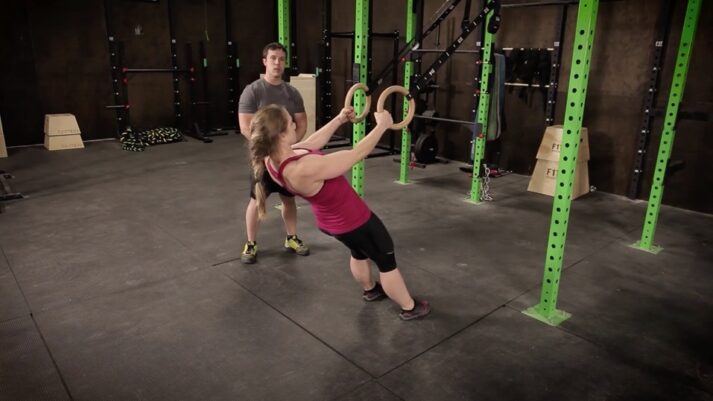
So what the hell is an inverted bodyweight row you ask?
GREAT QUESTION. In fact, it’s a question I get all the time in emails, so I figured I’d add it to the repertoire of explained exercises here on Nerd Fitness.
I’ll be using “bodyweight row” and “inverted row” interchangeably in this article.
You’ve probably heard of the regular barbell row. You pick up a barbell, bend over at the waist (keeping your back straight), and pull the weight up towards your chest.
This can be a great exercise, but improper form could cause complications or not give you a great workout!
Luckily, the inverted row takes care of all of that. You get to use your body weight, and there’s no extra stress on your back. As an added bonus, you get a decent core workout too.
This exercise has been referred to as the reverse bench press, as you grab a bar like you were getting ready to bench press it, but instead of lifting the weight down towards you, you’re pulling your body up towards the bar. Think of it like this: “benchpress” is to “pushing” as “inverted row” is to “pulling.”
Balance FTW!
Why the inverted bodyweight row is so great: I’m a huge fan of compound exercises (like the squat and deadlift, pull-ups and push-ups), and I’m also a huge fan of exercises that don’t require expensive machines or lots of extra bells and whistles.
An inverted row works all of your pull muscles: your back, biceps, traps, and all the stabilizer muscles in between. If you’ve been doing just pushups and bench presses, you need to start doing an equal amount of work with your back to stay in balance and away from injury.
If you want to eventually be able to do pull-ups, THIS is the exercise you need to add into your routine until you can do a full pull up.
Speaking of which, if you are just getting started with bodyweight rows to eventually do a pull-up, download our free, comprehensive guide, Strength Training 101: Everything You Need to Know.
In it, we have workout plans to follow whether you’re at home doing bodyweight training or at the gym with weights. Put your email in the box below and I’ll send you the guide free so you can get started today!
Download our comprehensive guide
- Everything you need to know about getting strong.
- Workout routines for bodyweight AND weight training.
- How to find the right gym and train properly in one.
How To Do An Inverted Bodyweight Row
Let’s start with the people who have access to a gym (see a variation for No-Gym people at the end). You know I hate machines for pretty much every exercise, due to the fact they restrict your body’s natural tendency to move.
I grabbed a video of Staci from Team NF demonstrating a bodyweight row with gymnastic rings from our premium course (The Nerd Fitness Academy), but don’t worry if you don’t have rings – you can see how to do them with a Smith Machine or barbell under this demonstration.
How to do a bodyweight row with explanation:
If you don’t have rings, here’s Staci demonstrating the same movement, just with an anchored barbell in a squat rack:
- Lie on the floor underneath the bar (which should be set just above where you can reach from the ground).
- Grab the bar with an overhand grip (palms facing AWAY from you).
- Contract your abs, and try to keep your body a completely straight line. Your ears, shoulders, hips legs, and feet should all be in a straight line.
- Pull yourself up to the bar until your chest touches the bar.
- Lower yourself back down.
If you’re still struggling and they’re too difficult, it’s okay. We just need to back up a few steps. Set the bar higher so that when you lean back, your body isn’t down on the ground; maybe it’s only at a 45 degree angle.
Here’s Staci again demonstrating it at a higher angle:
By setting the bar higher and your body higher, it takes more of your body weight out of the equation. As you get stronger (and/or lose weight), you’ll be able to drop the bar until you’re parallel when pulling yourself up.
Some tips and tricks:
- Don’t let your butt sag (squeeze your buttcheeks, flex your stomach, and keep your body rigid from head to toe).
- Don’t flail your elbows. Grab the bar with your hands a little closer than you would if you were doing a bench press, and keep your elbows at that angle from your body.
- Pull the bar towards the middle of your chest. Don’t pull the bar up towards your throat, or down towards your belly button. Right in the middle!
- Keep your abs tight. Keep your abs tight throughout the whole routine. Your body should be a straight line the whole time, and the only thing moving is your arms
- Think of pulling your shoulder blades together at the top of the exercise.
- GO all the way. Don’t half-ass it. Lower yourself until your arms are completely extended, and raise yourself until your chest touches the bar.
When should you do this exercise:
When I go into a gym, my time is extremely limited, and I’m working towards developing strength. I’ll try to do one leg exercise (either squats or deadlifts), followed by a pushing exercise (either bench press or overhead press), and then a pulling exercise (pull ups or inverted rows). Here’s a sample two day split for me:
- Day 1: Squats, bench press, inverted rows, dips
- Day 2: OFF
- Day 3: Deadlifts, Overhead Press, Pull Ups (or chin ups), Planks (Floor Swipes).
- Day 4: OFF
Both days work my full body, I can do a full routine in less than 40 minutes, and I’m building strength. If you can’t do dips on Day 1, you can do pushups. If you can’t do pull ups on day 2, you can substitute assisted pull ups or lat pull downs (although I don’t like lat pull downs very much).
On the rows, aim for 3 sets of 10. If you can’t do that, do 3 sets to exhaustion, and build your way up to 3 sets of 10. Once you can do that, put your feet up on a chair, throw some weights in a backpack, put it on reverse (so the bag is hanging in front of you), and then do the rows.
You got this.
If you are doing this on your own, but are overwhelmed and confused about strength training, I know how that feels. It can be scary enough to keep MOST people from starting, which is actually why we created our 1-on-1 Coaching Program. Our coach gets to know you, builds a program based on your experience and goals, will check your form on each movement (via video), and keep you accountable and on track!
You can learn more about our coaches and schedule a free call with us by clicking the image below:
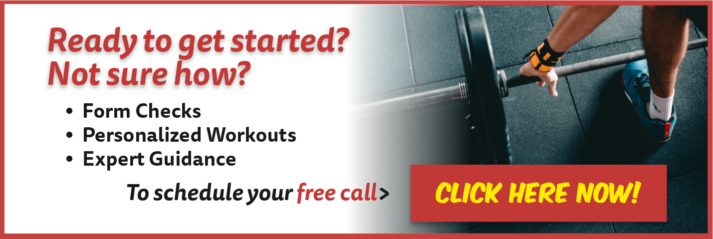
What if I don’t have access to a gym?
Just because you don’t have access to a gym doesn’t mean you can’t work out your back, you just need to get VERY creative. Try these few things for example:
- Get a really thick wooden dowel or pipe, something strong enough to support your weight. Lie it across two of your kitchen chairs, and then lie down underneath it. Make sure its sturdy, and the bar isn’t going to break/move on ya, and pull yourself up.
- Use your kitchen table. Or your desk (if it’s in the middle of the room and doesn’t have a back). Be very careful with this one. Lie underneath your table so your head and shoulder are sticking out above it. Grab the table edge with an overhand grip, and pull yourself up (just like it’s explained above). Warning, don’t pull the table over with you, and make sure you’re not gonna break the thing. Obviously this is a pretty crude way to get the job done, but it works.
Don’t forget, you want to stay in balance. Don’t just do push ups at home if you can help it, try to work out your back too. If you don’t have a pull up bar, find a way to do some bodyweight rows whether it’s between two chairs or under a table. You’re smart, get creative.
Here’s a video of me explaining how to do Inverted Body Weight Rows using just my kitchen table:
This is a great movement that can help you get started to building up your often ignored pull muscles. If you have poor posture, and spend all day at a desk hunched over a keyboard, mixing in bodyweight rows to your routine can be incredibly beneficial!
Any more questions about the inverted bodyweight row? Leave em below!
-Steve
PS: Be sure to check out the rest of the Strength Training 101 series:
You can also get the guide free when you sign up in the box below and join the Rebellion!
Download our comprehensive guide
- Everything you need to know about getting strong.
- Workout routines for bodyweight AND weight training.
- How to find the right gym and train properly in one.
PPS: Looking for more specific instruction? I’ll again remind you of our 1-on-1 Online Coaching Program! Your own Nerd Fitness Coach who will get to know you, your goals, and your lifestyle, and develop a workout plan (with rows) that’s specific to not only your body, but also to your schedule and life.
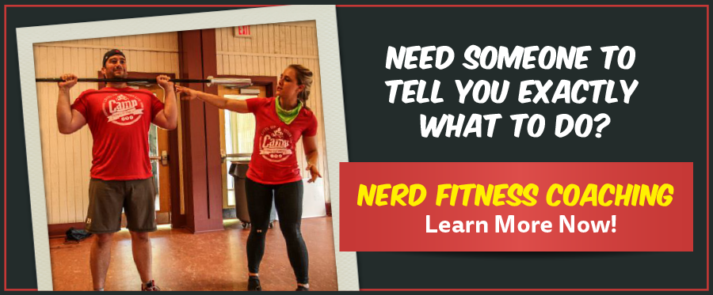
###
Source https://www.nerdfitness.com/blog/inverted-row-are-you-missing-out-on-this-great-exercise/
When I go to the gym, I try to keep things as simple and efficient as possible.
I’m a huge supporter of pull ups and chin ups, as those are the exercises that are a great test of somebody’s fitness level.
There’s just something inherently badass about being able to lift up your entire body, which is why competitions like Ninja Warrior require ridiculous back and bicep strength.
I know many people reading this article could be just getting started with fitness training, and doing a pull up seems like an absolute impossibility.
That’s okay! I’d guess that 80% of this country probably can’t do a pull up either, so don’t beat yourself up too much. Just because you can’t do a pull up now doesn’t mean you shouldn’t work out your back.
We HAVE written a resource on how to get your first pull-up here, but let’s start with the steps before that!
I have just the exercise for you instead: the bodyweight row! It’s a great exercise you can work on as you start to delve deeper into the wonderful world of strength training!
The Bodyweight (Inverted) Row

So what the hell is an inverted bodyweight row you ask?
GREAT QUESTION. In fact, it’s a question I get all the time in emails, so I figured I’d add it to the repertoire of explained exercises here on Nerd Fitness.
I’ll be using “bodyweight row” and “inverted row” interchangeably in this article.
You’ve probably heard of the regular barbell row. You pick up a barbell, bend over at the waist (keeping your back straight), and pull the weight up towards your chest.
This can be a great exercise, but improper form could cause complications or not give you a great workout!
Luckily, the inverted row takes care of all of that. You get to use your body weight, and there’s no extra stress on your back. As an added bonus, you get a decent core workout too.
This exercise has been referred to as the reverse bench press, as you grab a bar like you were getting ready to bench press it, but instead of lifting the weight down towards you, you’re pulling your body up towards the bar. Think of it like this: “benchpress” is to “pushing” as “inverted row” is to “pulling.”
Balance FTW!
Why the inverted bodyweight row is so great: I’m a huge fan of compound exercises (like the squat and deadlift, pull-ups and push-ups), and I’m also a huge fan of exercises that don’t require expensive machines or lots of extra bells and whistles.
An inverted row works all of your pull muscles: your back, biceps, traps, and all the stabilizer muscles in between. If you’ve been doing just pushups and bench presses, you need to start doing an equal amount of work with your back to stay in balance and away from injury.
If you want to eventually be able to do pull-ups, THIS is the exercise you need to add into your routine until you can do a full pull up.
Speaking of which, if you are just getting started with bodyweight rows to eventually do a pull-up, download our free, comprehensive guide, Strength Training 101: Everything You Need to Know.
In it, we have workout plans to follow whether you’re at home doing bodyweight training or at the gym with weights. Put your email in the box below and I’ll send you the guide free so you can get started today!
Download our comprehensive guide
- Everything you need to know about getting strong.
- Workout routines for bodyweight AND weight training.
- How to find the right gym and train properly in one.
How To Do An Inverted Bodyweight Row
Let’s start with the people who have access to a gym (see a variation for No-Gym people at the end). You know I hate machines for pretty much every exercise, due to the fact they restrict your body’s natural tendency to move.
I grabbed a video of Staci from Team NF demonstrating a bodyweight row with gymnastic rings from our premium course (The Nerd Fitness Academy), but don’t worry if you don’t have rings – you can see how to do them with a Smith Machine or barbell under this demonstration.
How to do a bodyweight row with explanation:
If you don’t have rings, here’s Staci demonstrating the same movement, just with an anchored barbell in a squat rack:
- Lie on the floor underneath the bar (which should be set just above where you can reach from the ground).
- Grab the bar with an overhand grip (palms facing AWAY from you).
- Contract your abs, and try to keep your body a completely straight line. Your ears, shoulders, hips legs, and feet should all be in a straight line.
- Pull yourself up to the bar until your chest touches the bar.
- Lower yourself back down.
If you’re still struggling and they’re too difficult, it’s okay. We just need to back up a few steps. Set the bar higher so that when you lean back, your body isn’t down on the ground; maybe it’s only at a 45 degree angle.
Here’s Staci again demonstrating it at a higher angle:
By setting the bar higher and your body higher, it takes more of your body weight out of the equation. As you get stronger (and/or lose weight), you’ll be able to drop the bar until you’re parallel when pulling yourself up.
Some tips and tricks:
- Don’t let your butt sag (squeeze your buttcheeks, flex your stomach, and keep your body rigid from head to toe).
- Don’t flail your elbows. Grab the bar with your hands a little closer than you would if you were doing a bench press, and keep your elbows at that angle from your body.
- Pull the bar towards the middle of your chest. Don’t pull the bar up towards your throat, or down towards your belly button. Right in the middle!
- Keep your abs tight. Keep your abs tight throughout the whole routine. Your body should be a straight line the whole time, and the only thing moving is your arms
- Think of pulling your shoulder blades together at the top of the exercise.
- GO all the way. Don’t half-ass it. Lower yourself until your arms are completely extended, and raise yourself until your chest touches the bar.
When should you do this exercise:
When I go into a gym, my time is extremely limited, and I’m working towards developing strength. I’ll try to do one leg exercise (either squats or deadlifts), followed by a pushing exercise (either bench press or overhead press), and then a pulling exercise (pull ups or inverted rows). Here’s a sample two day split for me:
- Day 1: Squats, bench press, inverted rows, dips
- Day 2: OFF
- Day 3: Deadlifts, Overhead Press, Pull Ups (or chin ups), Planks (Floor Swipes).
- Day 4: OFF
Both days work my full body, I can do a full routine in less than 40 minutes, and I’m building strength. If you can’t do dips on Day 1, you can do pushups. If you can’t do pull ups on day 2, you can substitute assisted pull ups or lat pull downs (although I don’t like lat pull downs very much).
On the rows, aim for 3 sets of 10. If you can’t do that, do 3 sets to exhaustion, and build your way up to 3 sets of 10. Once you can do that, put your feet up on a chair, throw some weights in a backpack, put it on reverse (so the bag is hanging in front of you), and then do the rows.
You got this.
If you are doing this on your own, but are overwhelmed and confused about strength training, I know how that feels. It can be scary enough to keep MOST people from starting, which is actually why we created our 1-on-1 Coaching Program. Our coach gets to know you, builds a program based on your experience and goals, will check your form on each movement (via video), and keep you accountable and on track!
You can learn more about our coaches and schedule a free call with us by clicking the image below:

What if I don’t have access to a gym?
Just because you don’t have access to a gym doesn’t mean you can’t work out your back, you just need to get VERY creative. Try these few things for example:
- Get a really thick wooden dowel or pipe, something strong enough to support your weight. Lie it across two of your kitchen chairs, and then lie down underneath it. Make sure its sturdy, and the bar isn’t going to break/move on ya, and pull yourself up.
- Use your kitchen table. Or your desk (if it’s in the middle of the room and doesn’t have a back). Be very careful with this one. Lie underneath your table so your head and shoulder are sticking out above it. Grab the table edge with an overhand grip, and pull yourself up (just like it’s explained above). Warning, don’t pull the table over with you, and make sure you’re not gonna break the thing. Obviously this is a pretty crude way to get the job done, but it works.
Don’t forget, you want to stay in balance. Don’t just do push ups at home if you can help it, try to work out your back too. If you don’t have a pull up bar, find a way to do some bodyweight rows whether it’s between two chairs or under a table. You’re smart, get creative.
Here’s a video of me explaining how to do Inverted Body Weight Rows using just my kitchen table:
This is a great movement that can help you get started to building up your often ignored pull muscles. If you have poor posture, and spend all day at a desk hunched over a keyboard, mixing in bodyweight rows to your routine can be incredibly beneficial!
Any more questions about the inverted bodyweight row? Leave em below!
-Steve
PS: Be sure to check out the rest of the Strength Training 101 series:
You can also get the guide free when you sign up in the box below and join the Rebellion!
Download our comprehensive guide
- Everything you need to know about getting strong.
- Workout routines for bodyweight AND weight training.
- How to find the right gym and train properly in one.
PPS: Looking for more specific instruction? I’ll again remind you of our 1-on-1 Online Coaching Program! Your own Nerd Fitness Coach who will get to know you, your goals, and your lifestyle, and develop a workout plan (with rows) that’s specific to not only your body, but also to your schedule and life.

###
Source https://www.theminimalists.com/black/
By Joshua Fields Millburn & Ryan Nicodemus · Follow: Facebook, Twitter, Instagram
Here we are, in the midst of what is supposedly the most joyous time of year: the holiday season. And yet, for most of us, it’s also the most stressful time of year. At some point Santa Claus turned corporate, and the holiday season metamorphosed into the holiday shopping season.
Shopping. This one word, although birthed from great intentions, has fundamentally changed our outlook from blissful to grim, from jolly to anxious, from celebrating Christmas to surviving the holidays. It’s upsetting, and with consumption’s vicious inertia, it seems there’s no way for us to exit the speeding train of consumerism.
This Friday is the busiest shopping day of the year: Black Friday. (Boxing Day is the overseas equivalent.) Retailers prepare months in advance for this dark day—preparation that’s meant to stimulate our insatiable desire to consume: Doorbuster sales. New products. Gigantic newspaper ads. TV, radio, billboards. Sale, sale, sale! Early bird specials! One day only! Get the best deal! Act now! While supplies last. See store for details.
But as shiny as its facade may be, the pernicious aspects of Black Friday are not few. The pandemonium that takes place on this day is perhaps a broader metaphor for our culture as a whole—our consumer culture. On this day we consume gluttonously without regard for the harm we’re inflicting on ourselves. On this day greed becomes ravenous. On this day we live without real meaning, buying gifts to fill a void we can’t fill with material possessions.
Perhaps Twitter user Steven said it best: Black Friday is the day we trample people for things we don’t need, the day after being thankful for what we have.
Sadly, we participate in this insanity in the name of a holiday, as if buying gifts was an ideal way to celebrate Christmas. But thankfully we have options.
Instead of embracing Black Friday, you can refuse to buy material items for people to display your love; rather, you can showcase your love, caring, and affection through daily actions—every day, not just holidays.
If you want to give gifts, why not gift an experience: a nice meal, tickets to a concert, a sunset on the beach? After all, the best, most loving gift you can give someone is your time and undivided attention. Presence is the best present.
Or, if that doesn’t work, maybe you can buy everyone on your Christmas list a giant trash can so they can throw away all the presents they received, but didn’t ask for.
If you found value in this essay, regift it to your friends and family.
The post Let’s Talk About Black Friday appeared first on The Minimalists.
Source https://www.theminimalists.com/black/
By Joshua Fields Millburn & Ryan Nicodemus · Follow: Facebook, Twitter, Instagram
Here we are, in the midst of what is supposedly the most joyous time of year: the holiday season. And yet, for most of us, it’s also the most stressful time of year. At some point Santa Claus turned corporate, and the holiday season metamorphosed into the holiday shopping season.
Shopping. This one word, although birthed from great intentions, has fundamentally changed our outlook from blissful to grim, from jolly to anxious, from celebrating Christmas to surviving the holidays. It’s upsetting, and with consumption’s vicious inertia, it seems there’s no way for us to exit the speeding train of consumerism.
This Friday is the busiest shopping day of the year: Black Friday. (Boxing Day is the overseas equivalent.) Retailers prepare months in advance for this dark day—preparation that’s meant to stimulate our insatiable desire to consume: Doorbuster sales. New products. Gigantic newspaper ads. TV, radio, billboards. Sale, sale, sale! Early bird specials! One day only! Get the best deal! Act now! While supplies last. See store for details.
But as shiny as its facade may be, the pernicious aspects of Black Friday are not few. The pandemonium that takes place on this day is perhaps a broader metaphor for our culture as a whole—our consumer culture. On this day we consume gluttonously without regard for the harm we’re inflicting on ourselves. On this day greed becomes ravenous. On this day we live without real meaning, buying gifts to fill a void we can’t fill with material possessions.
Perhaps Twitter user Steven said it best: Black Friday is the day we trample people for things we don’t need, the day after being thankful for what we have.
Sadly, we participate in this insanity in the name of a holiday, as if buying gifts was an ideal way to celebrate Christmas. But thankfully we have options.
Instead of embracing Black Friday, you can refuse to buy material items for people to display your love; rather, you can showcase your love, caring, and affection through daily actions—every day, not just holidays.
If you want to give gifts, why not gift an experience: a nice meal, tickets to a concert, a sunset on the beach? After all, the best, most loving gift you can give someone is your time and undivided attention. Presence is the best present.
Or, if that doesn’t work, maybe you can buy everyone on your Christmas list a giant trash can so they can throw away all the presents they received, but didn’t ask for.
If you found value in this essay, regift it to your friends and family.
The post Let’s Talk About Black Friday appeared first on The Minimalists.
Source https://www.foodpolitics.com/2018/12/weekend-reading-the-2018-global-nutrition-report/
If you want an overview of the current status of nutrition problems in the world, what is being done about them, and what needs to be done about them, this report is required reading (to get to the download button for the entire report, scroll to the end of the page).
The report is chock full of useful facts, figures, case studies, and recommendations. A massive undertaking, it
was produced by the Independent Expert Group of the Global Nutrition Report, supported by the Global Nutrition Report Stakeholder Group and the Secretariat at Development Initiatives. The writing was led by the co-chairs Jessica Fanzo and Corinna Hawkes, supported by group members and supplemented by additional analysts and contributors.
For a quick overview, go right to the slide deck and then to the graphics in the executive summary.
The report deals both with problems of malnutrition (undernutrition) and obesity (overnutrition), especially in children.
 It also deals with adult obesity:
It also deals with adult obesity:
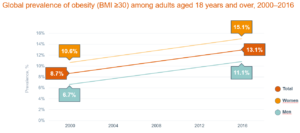
It identifies measurable nutrition indicators that can be used to track progress:
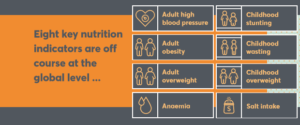
It recommends actions to reduce the prevalence of malnutrition and obesity.
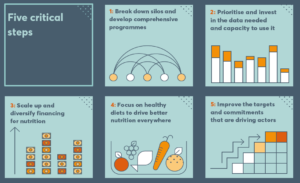
What stands in the way of implementing these steps? Political will, alas.
These reports have come out annually since 2014. Let’s hope this one gets the attention it deserves.
Source https://www.foodpolitics.com/2018/12/weekend-reading-the-2018-global-nutrition-report/
If you want an overview of the current status of nutrition problems in the world, what is being done about them, and what needs to be done about them, this report is required reading (to get to the download button for the entire report, scroll to the end of the page).
The report is chock full of useful facts, figures, case studies, and recommendations. A massive undertaking, it
was produced by the Independent Expert Group of the Global Nutrition Report, supported by the Global Nutrition Report Stakeholder Group and the Secretariat at Development Initiatives. The writing was led by the co-chairs Jessica Fanzo and Corinna Hawkes, supported by group members and supplemented by additional analysts and contributors.
For a quick overview, go right to the slide deck and then to the graphics in the executive summary.
The report deals both with problems of malnutrition (undernutrition) and obesity (overnutrition), especially in children.
 It also deals with adult obesity:
It also deals with adult obesity:

It identifies measurable nutrition indicators that can be used to track progress:

It recommends actions to reduce the prevalence of malnutrition and obesity.

What stands in the way of implementing these steps? Political will, alas.
These reports have come out annually since 2014. Let’s hope this one gets the attention it deserves.
Source https://www.niashanks.com/never-have-bad-luck-again/
 Would you rather listen to this article? Use the player below, download it, or use iTunes.
Would you rather listen to this article? Use the player below, download it, or use iTunes.
We interrupt your regularly scheduled article filled with practical strength training and nutrition information to help you build a healthier body without resorting to miserable dieting tactics or grueling workouts to bring you this important message about bad luck, soggy hiking boots, and a bit of optometry.
Imagine for a moment you and I are going on a hike together on a midsummer afternoon. We choose a trail that cuts through a thick forest.
As we begin, I comment on the remnants of trash littering the entrance of the trail. “Stupid people who are too lazy to throw away their garbage,” I grumble. Minutes later I point out the poison ivy that edges the trail, and then the venomous snake sunbathing a few yards past that and say, “Ugh, I hate snakes and poison ivy. Those could ruin this day quickly.”
An hour into the hike the trails winds through the pine needle covered forest floor and I remark on the suffocating humidity, scorching sun, the thorns that tear into my shins, the blister forming on my left heel, and the fatigue setting in. We approach a swollen stream and cautiously tip-toe across on the exposed rocks. Despite our efforts we both slip and have a foot submerge into the water. “What else could go wrong!” I fuss as I shake the excess water out of my soggy boot.
I am, apparently, miserable. But not you. A smile has been glued to your face since the hike began.
When I saw garbage littering the trail head, you spotted flowers blooming in the sunshine squeezing between the trees. When I whined about the poison ivy and snake you filled your lungs with fresh air and watched a hawk soar above the treetops. When I bellyached about the oppressive humidity and heat you soaked in midsummer’s beauty and her bounty. While I complained about getting tired and my blister collection and scrapes, you welcomed the invigorating challenge. When I was cursing my soggy boot, you kept walking and laughed with each squish of your saturated foot.
And there we were. Two people on the same trail, in the same situation. Yet each of us had two remarkably different experiences. It’s almost like we hiked two different trails.
We’ve all known someone (maybe we are that someone) who claims to be the recipient of never-ending bad luck. It’s like the world singled them out because terrible things always happen to them … so they boldly claim. They get sick; their car breaks down; the air conditioner goes out in the middle of summer on a holiday weekend; their team lost the big game; someone took the last piece of cake at work; they get a nagging injury when they finally start working out. “This stuff always happens to me” is their motto. They fancy themselves a bad-luck magnet.
Break the Bad Luck Streak
Regardless of the choices we face or the events that happen throughout the day, we have two lenses we can choose to view them from. In one hand is the lens that distorts events as being “bad luck” or “shit” or “unfortunate.” In the other hand is the lens that homes in on what has happened, what is — free from distortion or distraction — and gives us the power to glimpse and choose to see “beauty” or “good” or, at the very least, reality. Without any messy extrapolation.
There was a time I frequently viewed events through the “shit” lens. Words like “suck” and “dislike” and “bad luck” and others with a negative connotation would pass my lips. Then I got a little older, a smidge wiser, and realized I could choose which lens to look through. With awareness and practice, I stopped picking up the “bad luck” lens and began choosing to see the good things.
Recommended article: You Owe It to Yourself to Give Fewer Shits
 A funny thing happens when we choose to look for the good, the beautiful things. We can see them everywhere, even in unexpected circumstances. Likewise, if we typically laser in on the bad or unfortunate things, we can avert our gaze and look elsewhere or, more simply, erase the “bad luck” or “unfortunate” labels we assign to them.
A funny thing happens when we choose to look for the good, the beautiful things. We can see them everywhere, even in unexpected circumstances. Likewise, if we typically laser in on the bad or unfortunate things, we can avert our gaze and look elsewhere or, more simply, erase the “bad luck” or “unfortunate” labels we assign to them.
Bad Luck and Fitness
This website is dedicated to providing health and fitness information that doesn’t suck. You may think this article is a departure from that goal, but you’d be wrong. The same mentality discussed above — choosing which lens to view events — can, and should be, applied to health and fitness.
Did you have a “bad” workout, or was showing up and getting it done a victory?
Did you “fail” when you ate pizza and ice cream and blew past your allotted caloric intake for the day, or did you have a great time socializing and enjoying your favorite foods knowing you’ll get back on track with the next meal?
Recommended article: One Simple Hack to Stop Screwing Yourself Over
Do you have a nagging ache or injury that’s preventing you from working out the way you’re accustomed to, or is this an opportunity to focus on what you can do and improve in exercises/areas you otherwise wouldn’t?
Did you “let yourself go” and gain excess weight over the years and now find yourself hating your body, or are you seeing the compounding effects of previous years of choices and now know you can start walking in a more healthful and rewarding direction?
Do you typically exercise to punish yourself for overeating or for having fat on your body, or will you choose to exercise to make yourself stronger and healthier and a better version of yourself?
No matter what situation you face today, tomorrow, the day after, you will have the choice of viewing the situation from one of two lenses. Which one will you hold in front of your eyes? What will you choose to see?
While you’re here, subscribe to the newsletter. You’ll receive a short email course to jump start your health and fitness journey, and you’ll get insider-only information. Enter your email below.
The post Never Have “Bad Luck” Again appeared first on Nia Shanks.
Source https://www.niashanks.com/never-have-bad-luck-again/
 Would you rather listen to this article? Use the player below, download it, or use iTunes.
Would you rather listen to this article? Use the player below, download it, or use iTunes.
We interrupt your regularly scheduled article filled with practical strength training and nutrition information to help you build a healthier body without resorting to miserable dieting tactics or grueling workouts to bring you this important message about bad luck, soggy hiking boots, and a bit of optometry.
Imagine for a moment you and I are going on a hike together on a midsummer afternoon. We choose a trail that cuts through a thick forest.
As we begin, I comment on the remnants of trash littering the entrance of the trail. “Stupid people who are too lazy to throw away their garbage,” I grumble. Minutes later I point out the poison ivy that edges the trail, and then the venomous snake sunbathing a few yards past that and say, “Ugh, I hate snakes and poison ivy. Those could ruin this day quickly.”
An hour into the hike the trails winds through the pine needle covered forest floor and I remark on the suffocating humidity, scorching sun, the thorns that tear into my shins, the blister forming on my left heel, and the fatigue setting in. We approach a swollen stream and cautiously tip-toe across on the exposed rocks. Despite our efforts we both slip and have a foot submerge into the water. “What else could go wrong!” I fuss as I shake the excess water out of my soggy boot.
I am, apparently, miserable. But not you. A smile has been glued to your face since the hike began.
When I saw garbage littering the trail head, you spotted flowers blooming in the sunshine squeezing between the trees. When I whined about the poison ivy and snake you filled your lungs with fresh air and watched a hawk soar above the treetops. When I bellyached about the oppressive humidity and heat you soaked in midsummer’s beauty and her bounty. While I complained about getting tired and my blister collection and scrapes, you welcomed the invigorating challenge. When I was cursing my soggy boot, you kept walking and laughed with each squish of your saturated foot.
And there we were. Two people on the same trail, in the same situation. Yet each of us had two remarkably different experiences. It’s almost like we hiked two different trails.
We’ve all known someone (maybe we are that someone) who claims to be the recipient of never-ending bad luck. It’s like the world singled them out because terrible things always happen to them … so they boldly claim. They get sick; their car breaks down; the air conditioner goes out in the middle of summer on a holiday weekend; their team lost the big game; someone took the last piece of cake at work; they get a nagging injury when they finally start working out. “This stuff always happens to me” is their motto. They fancy themselves a bad-luck magnet.
Break the Bad Luck Streak
Regardless of the choices we face or the events that happen throughout the day, we have two lenses we can choose to view them from. In one hand is the lens that distorts events as being “bad luck” or “shit” or “unfortunate.” In the other hand is the lens that homes in on what has happened, what is — free from distortion or distraction — and gives us the power to glimpse and choose to see “beauty” or “good” or, at the very least, reality. Without any messy extrapolation.
There was a time I frequently viewed events through the “shit” lens. Words like “suck” and “dislike” and “bad luck” and others with a negative connotation would pass my lips. Then I got a little older, a smidge wiser, and realized I could choose which lens to look through. With awareness and practice, I stopped picking up the “bad luck” lens and began choosing to see the good things.
Recommended article: You Owe It to Yourself to Give Fewer Shits
 A funny thing happens when we choose to look for the good, the beautiful things. We can see them everywhere, even in unexpected circumstances. Likewise, if we typically laser in on the bad or unfortunate things, we can avert our gaze and look elsewhere or, more simply, erase the “bad luck” or “unfortunate” labels we assign to them.
A funny thing happens when we choose to look for the good, the beautiful things. We can see them everywhere, even in unexpected circumstances. Likewise, if we typically laser in on the bad or unfortunate things, we can avert our gaze and look elsewhere or, more simply, erase the “bad luck” or “unfortunate” labels we assign to them.
Bad Luck and Fitness
This website is dedicated to providing health and fitness information that doesn’t suck. You may think this article is a departure from that goal, but you’d be wrong. The same mentality discussed above — choosing which lens to view events — can, and should be, applied to health and fitness.
Did you have a “bad” workout, or was showing up and getting it done a victory?
Did you “fail” when you ate pizza and ice cream and blew past your allotted caloric intake for the day, or did you have a great time socializing and enjoying your favorite foods knowing you’ll get back on track with the next meal?
Recommended article: One Simple Hack to Stop Screwing Yourself Over
Do you have a nagging ache or injury that’s preventing you from working out the way you’re accustomed to, or is this an opportunity to focus on what you can do and improve in exercises/areas you otherwise wouldn’t?
Did you “let yourself go” and gain excess weight over the years and now find yourself hating your body, or are you seeing the compounding effects of previous years of choices and now know you can start walking in a more healthful and rewarding direction?
Do you typically exercise to punish yourself for overeating or for having fat on your body, or will you choose to exercise to make yourself stronger and healthier and a better version of yourself?
No matter what situation you face today, tomorrow, the day after, you will have the choice of viewing the situation from one of two lenses. Which one will you hold in front of your eyes? What will you choose to see?
While you’re here, subscribe to the newsletter. You’ll receive a short email course to jump start your health and fitness journey, and you’ll get insider-only information. Enter your email below.
The post Never Have “Bad Luck” Again appeared first on Nia Shanks.




 It also deals with adult obesity:
It also deals with adult obesity:


 Would you rather listen to this article? Use the player below,
Would you rather listen to this article? Use the player below,  A funny thing happens when we choose to look for the good, the beautiful things. We can see them everywhere, even in unexpected circumstances. Likewise, if we typically laser in on the bad or unfortunate things, we can avert our gaze and look elsewhere or, more simply, erase the “bad luck” or “unfortunate” labels we assign to them.
A funny thing happens when we choose to look for the good, the beautiful things. We can see them everywhere, even in unexpected circumstances. Likewise, if we typically laser in on the bad or unfortunate things, we can avert our gaze and look elsewhere or, more simply, erase the “bad luck” or “unfortunate” labels we assign to them.